Monfragüe Park: Sanctuary of the Dams
Relief, climate and history
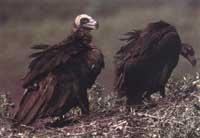
The natural park of Monfragüe has 17,582 hectares. Declared a National Park in 1979, it has been protected since then. It is a long and wide ravine, crossed by the Tagus River. The mountain range is framed by steep and dense forests of Mediterranean scrub. Geologically, the soils are very old; from the Precambrian to the Silúrico, with tertiary and quaternary deposits. It consists mainly of slates and quartzites. The relief is very abrupt and toothed, but with low altitude (between 300 and 570 m).
The Park is located entirely in the continental climate zone, although the influence of the Atlantic Ocean slightly softens this harsh climate. Four seasons stand out: winter is cold and summer hot (average temperature of 5 ° C in winter and 27 ° C in summer). In spring and autumn the temperature is usually temperate. Rainfall ranges from 600 to 1000 mm/year.
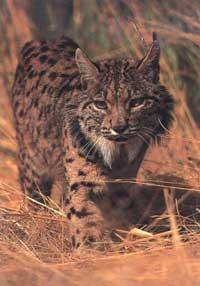
The cave paintings found in a coat have allowed us to know that in the Bronze Age man hunted in that area. The Visigoths built a castle in the heart of the current park, on a mountain. Tarik (Tarik ibn Zijad) and Muza (Musa ibn Nusair) were followed by the same chiefs. The stones of this castle stand today. At that time, which was dominated by the Muslims, the area was called Al-Mo> (steep) and hence derives Monfragüe, name of today (Incidentally, let’s say that one of the commandments within the park is called “Basque Majada”, but we have not been able to clarify the origin of this name).
Ecosystems
The park has three different ecosystems: forest, rocky and aquatic environment. The three are biologically rich and are in good condition. The forest is, without lips, the most valuable ecosystem, especially the 25 km long secularism on the right of the Tagus River. This environment is not altered by man. This closed forest, impenetrable by man, houses the three most famous species of the park: the lynx, the solar eagle and the relief. All three are in danger of extinction. Hence the importance of this unique ecosystem.
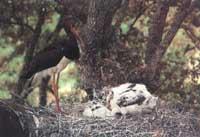
In the places where human influence has come, this closed forest has been cleared and is now in a grazing state, but cork oaks and oaks have been preserved, original species. Therefore, next to the closed forest are the most abundant angios of Estremadura. However, in some areas of the interior of the park the forest of origin has been replaced by eucalyptus invaders with higher productivity and land plow. Eucalyptus is, along with fire, the danger that threatens this ecosystem.
The second ecosystem is the rocky. Although not as important as the forest, it is really spectacular. The Tagus River has three large carved gorges (the largest is almost 300 m tall compared to the river level), formed by large quartz blocks. There live the griffon vulture, the relief and the black stork. These three species and their nests are easily observable from the main road through the park.
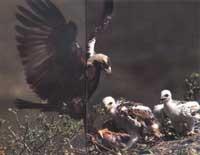
The third ecosystem is the Tagus and Tietar rivers. The Tietar River connects in the centre of Tajori Park. Both rivers have dam paths in the park itself. In addition, downstream, about 30 km from the park, the reservoir created by the Alcántara dam on the Tagus channel reaches the interior of the park. As a result, the water level in the park is higher than its own.
Vegetation
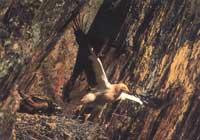
The vegetation of Monfragüe is varied and spectacular. The geographical distribution of plant species depends on the different microclimates within the park. The laios are more humid and with less sun. In them grow the trees and bushes larger and thicker, forming a dense and closed forest. The most common and abundant species of these umbris are the cork oak ( Quercus suber), the strawberry ( Arbutus unedo), the louse ( Quercus faginea), the heather ( Erica sp. ) and the northern white hawthorn ( Crataegus monogyna). In the solanas, on the other hand, the art more resistant to heat ( Quercus rotundifolia), the forest olive ( Olea sylvestris), the livestock ( Quercus coccifera), the spicy spatters ( Lavandula stoechas) and rosemary ( Rosmarinx officinalis) that cover the angial soils with purple flowers are the most common.
Wildlife
The park of Monfragüe is known for its fauna, quantity and quality. In fact, the last censuses of species produced last year show an increase in the number of endangered species.
Mammals are the most difficult to see in the park animals, as they hide in the forest. The most important is the Iberian lynx ( Lynx pardina), but it is not abundant in the park. In addition, there are wild boars, deer, ginets, foxes, wild cats, rabbits and field figs. In addition to mammals, other notable animals are the sliding tortoise ( Mauremis caspica), the stair snake ( Elaphe scalaris), the heron ( Lacerta lepida), the common toad ( Bufo bufo) and the southern frog ( Hyla meridionalis). In the fish there are about fifteen species, among which stand out the carp ( Cyprinus carpio) and the Iberian barb ( Barbus comiza).
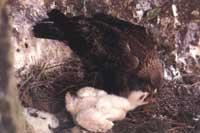
But the “stars” of the park are undoubtedly prey. In addition there are many and do not hide. They look unintentionally in the sky of Monfragüe as a spy, planning around, shameless and elegant. The sai beltza ( Aegypius monachus) houses the largest European colony (232 couples). On the other hand, the colony of griffon vulture ( Gyps fulvus) is very large (321 pairs). In addition, the most spectacular species are the solar eagle ("Aquila heliaca adalberti") (6 pairs), the "alimoche" (Neophron percnopterus) (16 pairs) and the black eagle ("Aquila chrysaetos") (4 pairs). Along with them you can see Bonelli eagles, large hawks, large mushrooms, snake eagles and more common black milanos.
The black stork ( Ciconia nigra) is the most important in non-predatory birds (9 pairs) and in smaller birds the blue mica ( Cyanopica cyanus).
Where to go and what to see
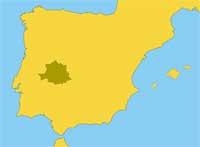
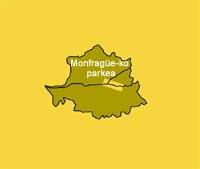
To access the park of Monfragüe you can use the roads that depart from the capital of Cáceres, Plasencia and Navalmoral de la Mata. Inside the park there is a unique village: Villarreal de San Carlos. There is an information office, bar, restaurant and tent. From there you can make several walking tours to know the most interesting corners of the park (all walks are short, 2-3 hours). To be able to see predators and black dirt well, at least binoculars are necessary). In addition, in the areas near the park (Torrejón el Rubio and Malpartida de Plasencia are the closest) there are accommodations and other services. The newly built Monfragüe campsite is next to the C-524, next to the Empalme-Monfragüe train station.
Buletina
Bidali zure helbide elektronikoa eta jaso asteroko buletina zure sarrera-ontzian











